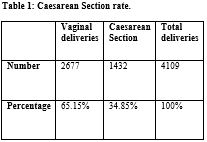“Rate and Indications of Caesarean section in the Apollo Institute of Medical Sciences and Research, Chittoor: A retrospective study”
Abstract
Aim: To determine the rate and indications of caesarean section.
Method: A retrospective studywas conducted at The Apollo Institute Of Medical Sciences And Research, Chittoor, for one year. Thedata was retrieved from the medical record of the operation theatre.
Results: During the studyperiod, 34.85% (1,432 out of 4109) of women underwent caesarean section. The majority of thewomen (80.02%) belonged to 20-30 years, and 69.13% had studied up to metric. The majority ofwomen, 78.35 %, were from a rural area, and 87.70 % belonged to middle socioeconomic status.Booked cases were 94.55%, and multigravida (54.53%) were the majority to undergo a caesareansection. The four leading indications were previous caesarean section (40.22%), fetal distress(17.94%), non-progress of labour (13.40%) and Oligo-Hydramnious (7.89%).
Conclusions: Therate of caesarean section is more than the national (India) and global caesarean section rate.Previous caesarean section is the main indication followed by fetal distress.
Downloads
References
2. Neilson JP. Interventions for suspected placenta praevia. Cochrane Database of Systematic Reviews 2003, Issue 1. DOI: 10.1002/ 14651858.CD001998.
3. Essendi H, Mills S, Fotso JC. Barriers to formal emergency obstetric care services’ utilization. Journal of Urban Health. 2011; 88(2):356-69. DOI: 10.1007/s11524-010-9481-1.
4. Kathuria B, Sherin Raj TP. Regional Disparities and Determinants of Caesarean Deliveries in India. Ind J Youth Adol Health 2020; 7(4): 15-23. DOI: 10.24321/2349.2880.202018.
5. Banerjee A, Bhadra B, Dey KR. Analysis of caesarean section in a tertiary care hospital, Assam, India. Int J Reprod Contracept Obstet Gynecol 2018;7:1514-7. DOI: 10.18203/2320-1770.ijrcog20181346.
6. Betran AP, Ye J, Moller A-B, et al. Trends and projections of caesarean section rates: global and regional estimates. BMJ Global Health 2021;6:e005671. DOI:10.1136/ bmjgh-2021-005671.
7. Kaur J, Singh S and Kaur K. Current trend of caesarean sections and vaginal births. Adv. Appl. Sci. Res.2013;4(4):196-202.
8. Begum T, Rahman A, Nababan H, Hoque DM, Khan AF, Ali T, et al. Indications and determinants of caesarean section delivery: Evidence from a population-based study in Matlab, Bangladesh. PloS one.2017 Nov;12(11):1-16. DOI: 10.1371/journal.pone.0188074.
9. Rebelo F, Da Rocha CM, Cortes TR, Dutra CL, Kac G. High caesarean prevalence in a national population- based study in Brazil: the role of private practice. Acta Obstetricia et Gynecol Scandinavica. 2010;89:903–8. DOI: 10.3109/00016349.2010.484044.
10. Apanga PA, Awoonor-Williams JK. Predictors of caesarean section in northern Ghana: a case-control study. Pan African Med J.2018;29:1–11. DOI: 10.11604/pamj.2018.29.20.13917.
11. Divyamol N, Raphael L, Koshy N. Caesarean section rate and its determinants in a rural area of South India. Int J Community Med Public Health 2016;3:2836-40. DOI: 10.18203/2394-6040.ijcmph20163370.
12. Ahmmed F, Manik MMR, Hossain MJ. Caesarian section (CS) delivery in Bangladesh: A nationally representative cross-sectional study. PLoS One. 2021 Jul 15;16(7):e0254777. DOI: 10.1371/journal.pone.0254777.
13. Reddy KM, Sailaja LP, Kodimala SC, Pathakamudi P, Betha K. Prevalence and determinants of caesarean section in a rural tertiary teaching hospital: a 6-year retrospective study. Int J Reprod Contracept Obstet Gynecol 2019;8:560-5. DOI: 10.18203/2320-1770.ijrcog20190284.
14. Dankwah E, Kirychuk S, Zeng W, Feng C, Farag M. Socioeconomic inequalities in the use of caesarean section delivery in Ghana: a cross-sectional study using nationally representative data. International journal for equity in health.2019; 18(1):162. DOI: 10.1186/s12939-019-1063-6.
15. Shrestha DB, Khatri R, Oli PR, Malla R, Shrestha C, Khatiwada R, Silwal P, Shah PB. Cesarean Section in a Maternity Unit of a Tertiary Care Center of Nepal: A Descriptive Cross-sectional Study. JNMA J Nepal Med Assoc. 2021 Apr 30;59(236):322-326. DOI: 10.31729/jnma.5150.
16. Tebeu PM, Mboudou E, Halle G, Kongnyuy E, Nkwabong E, Fomulu JN. Risk factors of delivery by caesarean section in cameroon (2003-2004): a regional hospital report. ISRN Obstet Gynecol. 2011; 2011: 791319. DOI:10.5402/2011/791319.
17. Chavda D, Goswam K, Dudhrejiya K. A cross sectional study of 1000 lower segment cesarean section in obstetrics and gynecology department of P. D. U. Medical College, Rajkot, Gujarat, India. Int J Reprod Contracept Obstet Gynecol 2017;6:1186-91. DOI: 10.18203/2320-1770.ijrcog20170916.
18. Yadav S, Kaur S, Yadav SS, Thakur B. Analysis of caesarean rate, indications and complications: review from medical college Ambala, Haryana, India. Int J Reprod Contracept Obstet Gynecol 2016;5:3326-9. DOI: 10.18203/2320-1770.ijrcog20163282.
19. Ganchimeg T, Ota E, Morisaki N, et al. Pregnancy and child birth outcomes among adolescent mothers: a World Health Organization multicountry study. BJOG. 2014; 121:40–8. DOI: 10.1111/1471-0528.12630.
20. Ethiraj G. Ramachandra A. Rajan S. Induction of Labor and Risk for Emergency Cesarean Section in Women at Term Pregnancy. J Clin Gynecol Obstet. 2019;8(1):17-20. DOI: 10.14740/jcgo433w.
21. Gurung RT, Gurung G, Shrestha R, Gurung T, Sharma P. Prevalence and Outcome of Cesarean Section at Gandaki Medical College Teaching Hospital and Research Centre, Pokhara, Nepal. Journal of Gandaki Medical College-Nepal. 2016;9(2):1-6. DOI: 10.3126/jgmcn.v9i2.17858.
22. Nicholson JM, Kellar LC. The Active Manage-ment of Impending Cephalopelvic Dispropor-tion in Nulliparous Women at Term: A Case Se-ries. J of Pregnancy. 2010;2010: Article ID708615. DOI: 10.1155/2010/708615.
23. Manjulatha B, Sravanthi TP. Caesarean section rates in a Teaching Hospital: a ten-year review. IOSR J Dent Med Sci. 2015:14(8):1-5. DOI: 10.9790/0853-14880105.
24. Gupta M, Garg V. The rate and indications of caesarean section in a teaching hospital at Jaipur, India. Int J Reprod Contracept Obstet Gynecol 2017;6:1786-92. DOI: 10.18203/2320-1770.ijrcog20171530.
25. Bauer ST, Bonanno C. Abnormal placentation. Semin Perinatol. 2009;33(2):88–96. DOI: 10.1053/j.semperi.2008.12.003.
26. Ayenew AA. Incidence, causes, and maternofetal outcomes of obstructed labor in Ethiopia: systematic review and meta-analysis. Reprod Health. 2021 Mar 10;18(1):61. DOI: 10.1186/s12978-021-01103-0.

Copyright (c) 2022 Author (s). Published by Siddharth Health Research and Social Welfare Society

This work is licensed under a Creative Commons Attribution 4.0 International License.


 OAI - Open Archives Initiative
OAI - Open Archives Initiative



















 Therapoid
Therapoid

